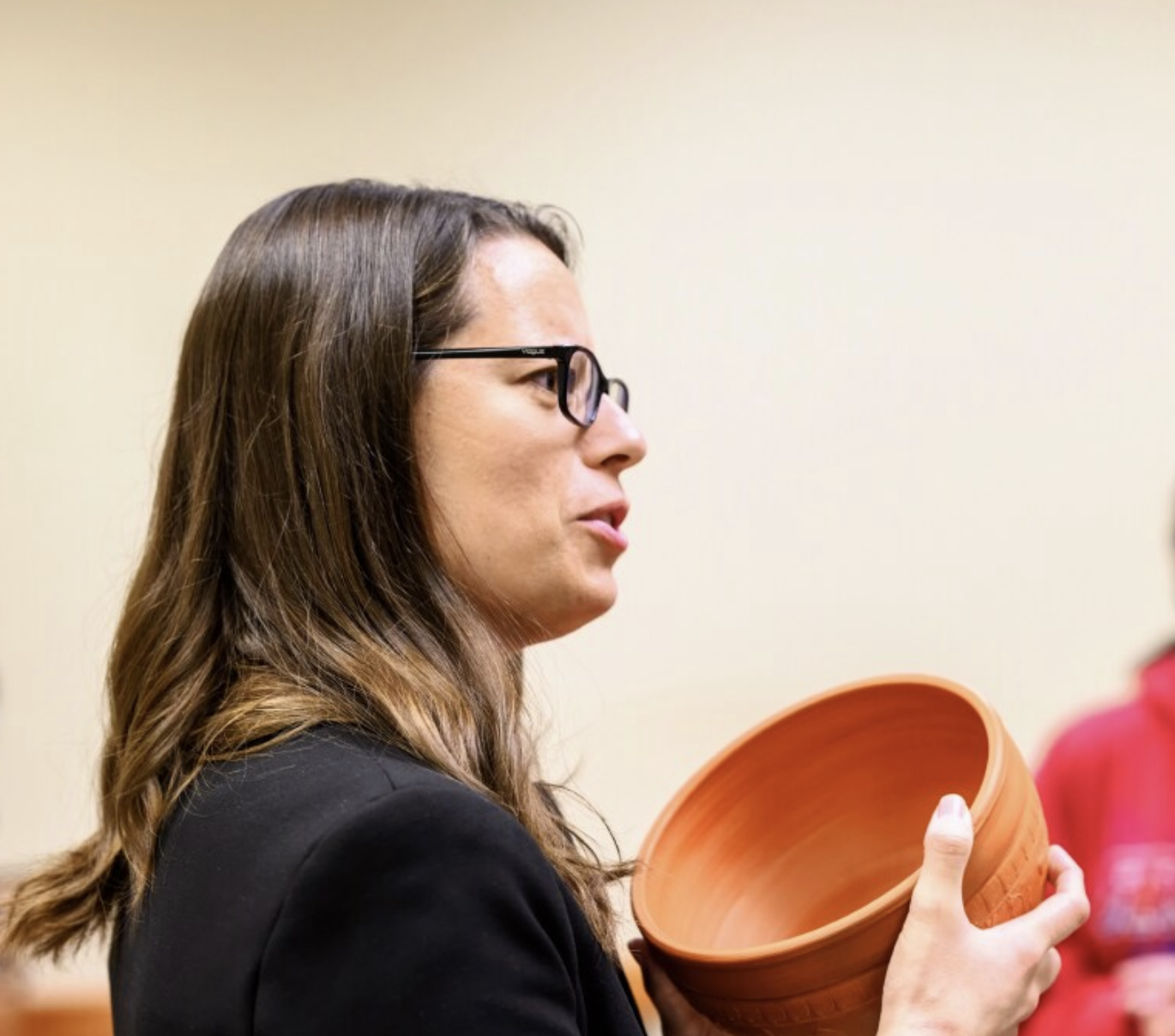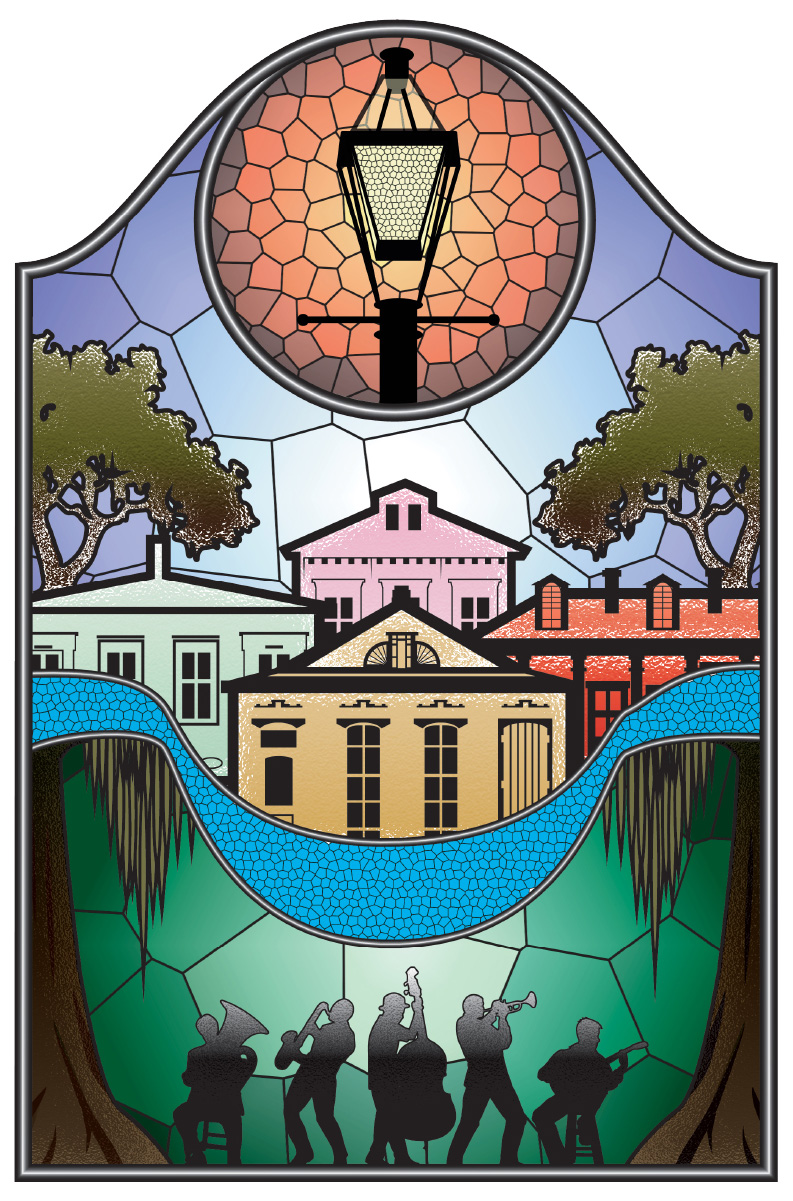“If I But Touch…I Will Be Made Well” An Ancient Christian Amulet at the ANS
Austin Goodwin Andrews
There are over three thousand objects depicting Jesus in the vault of the American Numismatic Society. While the vast majority of these images can be found on Byzantine coinage, one of the earliest figural representations of Jesus in the collection is not on a coin, but on an amulet carved in stone (Fig. 1). This engraved rock crystal features a Christian narrative tradition of Jesus in a dynamic moment of miraculous healing.


Figure 1. Translucent rock crystal intaglio amulet, sixth–seventh centuries CE, 30.1 mm × 20.4 mm × 4.7 mm. Obverse: Jesus Christ with a hand raised in blessing, on either side, two smaller suppliant figures with arms raised; to left, cross; reverse: a view of the same image, reversed, as seen through the material of the rock crystal. ANS 0000.999.36770.
Likely produced in sixth century Syria, an artisan carved, rounded, and smoothed this stone into a low, oblong dome. The flat face was then incised with representations of three figures and a cross. The large central figure facing forward is Jesus depicted with a triangular beard, heavy brow, and exaggerated, vertical eyes. He wears an outer cloak draped over his shoulders and raises one arm, his fingers extending in a gesture of blessing. Two smaller figures face him on either side. Below his raised arm, a veiled woman crouches in a posture of supplication. On the opposite side, below the cross, another suppliant raises a hand toward Jesus, but here the stone is chipped and the image breaks off. When viewed through the curved dome of the translucent rock crystal, the carving has a holographic effect, with the figures nearly appearing as miniature sculptures in the round (Fig. 2).

Figure 2. Translucent rock crystal intaglio amulet, sixth–seventh centuries CE, 30.1 mm × 20.4 mm × 4.7 mm. Same as the reverse of Figure 1, viewed at an angle. ANS 0000.999.36770.
The scene is found in the three Synoptic Gospels in the Christian Bible, in Mark 5:25–34, Matthew 9:20–22, and Luke 8:43–48. In each instance, a woman is healed from chronic, abnormal bleeding by her faith, as enacted through perceiving Jesus and touching his himation, or outer cloak. The account in Mark reads:
Now there was a woman who had been suffering from a flow of blood for twelve years. She had endured much under many physicians and had spent all that she had, and she was no better but rather grew worse. She had heard about Jesus and came up behind him in the crowd and touched his cloak, for she said, “If I but touch his cloak, I will be made well.” Immediately her flow of blood stopped, and she felt in her body that she was healed of her disease. Immediately aware that power had gone forth from him, Jesus turned about in the crowd and said, “Who touched my cloak?” And his disciples said to him, “You see the crowd pressing in on you; how can you say, ‘Who touched me?’” He looked all around to see who had done it. But the woman, knowing what had happened to her, came in fear and trembling, fell down before him, and told him the whole truth. He said to her, “Daughter, your faith has made you well; go in peace, and be healed of your disease.” (Mark 5:25–34, NRSVUE)
In Late Antique and Early Christian Gems, Jeffrey Spier (2013) groups this rock crystal and more than thirty other objects as coming from a “prolific workshop” in the sixth and seventh centuries that “specialized in the production of rock crystal pendants engraved with Christian images.” He describes that for each of these stones, “the engraved gem was inlaid with gold foil, sandwiched with a second, unengraved rock crystal of identical shape, and mounted in a gold frame with [a] suspension loop to be worn as a pendant” (p. 115). Other extant objects from this workshop give an idea of how this gem would have originally been installed in a mount, such as one in the collection of the British Museum (Fig. 3).
While the veiled suppliant on the ANS amulet represents the unnamed woman healed from a constant flow of blood met with a flow of power, the identity of the other figure approaching Jesus is less clear. He could be one of the disciples who responds to Jesus during his interaction with the woman or from a related narrative. One possibility is that he represents Jairus, a character named as the leader of a synagogue from the broader circumstance that frames this brief story. Before Jesus encounters the bleeding woman, he is approached by Jairus seeking help for his terminally ill daughter, whom others then say has just died. After, Jesus goes to Jairus’ house and declares, “The child is not dead but asleep.” He then tells her to get up, which she does, healthily (Mark 5:41–43).

Figure 3. Translucent rock crystal intaglio amulet set in gold mount, sixth–seventh centuries CE, 31.5 mm (pendant); c. 23 mm × 15 mm (gem). Obverse: nimbate Christ with a hand raised in blessing over a smaller figure, seen through the material of the rock crystal, cross. Reverse: not pictured. British Museum, 1972,0505.1; © The Trustees of the British Museum (CC BY-NC-SA 4.0).
Alternatively, Spier suggests the suppliant may be carrying a staff, in which case he could be identified as a blind man from another miracle story from the Gospels, with the staff employed as iconographic shorthand for the man’s blindness. This story also features physical contact in addition to the use of physical material—saliva—to facilitate the miracle:
They came to Bethsaida, and some people brought a blind man and begged Jesus to touch him. He took the blind man by the hand and led him outside the village. When he had spit on the man’s eyes and put his hands on him, Jesus asked, “Do you see anything?” He looked up and said, “I see people; they look like trees walking around.” Once more Jesus put his hands on the man’s eyes. Then his eyes were opened, his sight was restored, and he saw everything clearly. (Mark 8:22–25, NRSVUE)
This interpretation can also be read in conjunction with the British Museum example (Fig. 3). It depicts a nimbate Jesus with a hand raised in blessing over a smaller figure to the left, whom scholars have variously identified as the blind man or the bleeding woman.

Figure 4. Red, green, and yellow bloodstone intaglio set in a gilt silver mount, sixth–seventh centuries CE (?), 50 mm × 37 mm × 10 mm (pendant), 48 mm × 36 mm × 10 mm (gem). Obverse: historiola of Mark 5:25–34, starting with a small cross, inscribed with serif script surrounding figures of Christ with a cruciform nimbus and a veiled suppliant woman; reverse: small cross, continuation of the historiola in sans serif script around an orant who is flanked by two palm fronds, identifiable as the Theotokos, the woman in a healed state, or, more generally, as a stock representation of prayer. Metropolitan Museum of Art, 17.190.491; public domain.
The interaction between a veiled suppliant representing the bleeding woman and Jesus is also featured on the obverse of a large, two-sided amulet at the Metropolitan Museum of Art (Fig. 4). On this colorful bloodstone amulet, the woman approaches a nimbate Jesus who holds a Gospel book with a cross on it. Here, the woman prostrates herself either in the moment just before her healing or immediately thereafter—coming “in fear and trembling,” falling down, and telling him “the whole truth.” An abbreviated portion of the Mark 5 text quoted above is inscribed around these three figures, running continuously from the obverse onto the reverse. This is consistent with other citations of biblical texts as charms for healing, called historiolae, used on other amulets in the ancient eastern Mediterranean, that were thought to enact change in reality.
This specific narrative of miraculous healing lends itself well to such amuletic objects, as physical materials imagined to effect healing and protection. The woman’s act of touching Jesus’s garment in the biblical account signifies her faith in Christ and his healing power. Her action of touch functions as a conduit for the healing, demonstrating an immediate link between the physical contact and her faith. The individuals who either commissioned or made these amulets intended them to be more than just visual representation; instead, they were meant to be tangible objects for someone seeking healing to both hold and behold, as mirrors to the experience of the woman described as healed through touch in the Gospel narrative.
That the amulet is made of rock crystal adds another important dimension to this object. When the engraving is viewed through the dome of the rock crystal, white light and the whole visual spectrum of colors flicker around Jesus’s person and the supplicants. The original setting, whether gold or colored glass, would have added further to this luminous effect.
Light was a common description of manifest power in early Christian texts, as in the scene of the Transfiguration, when Jesus’s “face shone like the sun, and his clothes became bright as light” (Matthew 17:2). Descriptions of this illumination became fodder for late antique Christian art, such as in the example of the sixth century apse mosaic in the church of the Monastery of St. Catherine on Mount Sinai depicting the Transfiguration (Fig. 5). Here, Jesus is shown standing in a radiant mandorla, or full-body halo, with one hand raised in blessing. Depicted rays of light shine out from his body and he is engulfed in an ethereal ground made of reflective glass and gold tesserae, which add to the overall light show of the representation.

Figure 5. Mosaic, Transfiguration of Christ, Apse Mosaic from the Church of the Virgin, Mount Sinai, Egypt. Europa Nostra, © CCA, Centro di Conservazione Archeologica – Roma (CC BY-NC-SA 2.0).
Similarly, the interplay of light on the rock crystal gem, with its iridescent and light-refracting properties, corresponds to this same kind of power being emanated. The smoothed oval stone can even be seen as a three-dimensional mandorla itself, which appears to radiate actual light. The biblical narrative of the bleeding woman being healed refers to a curious instance of “power” exiting the body of Jesus in the moment of her touching his himation (Mark 5:30). This may be further relevant to interpreting the object and its function. Power, visualized here as light flowing from Jesus outward to the supplicants, can also be understood as being contained within the amulet.
The artisans who conceived and crafted this object engaged traditions about Jesus’s life that included healing miracles, as well as creatively incorporated visual effects to reflect this transformative power. Altogether, this object harnesses early Christian artistic and narrative traditions as a potent manifestation of divine power. Beyond illustrating textual accounts, the amulet was made to be like the cloak or saliva from the healing narratives: a material that enacted healing or protection. The amulet, as something portable, visual, and haptic, invites users into pious faith and allows them to access power and healing directly as it glitters in the stone. A user, whether wearing the piece on a chain against their body or held in their hand, could think, “If I but touch… I will be made well.”
Austin Goodwin Andrews (austin.andrews@yale.edu), ANS Associate Member, is completing a Master of Arts in Religion at Yale Divinity School and Yale’s Institute of Sacred Music, concentrating on religion, visual art, and material culture.




